This “Limited Edition” Blu-ray box set from Arrow Video is currently available for purchase.
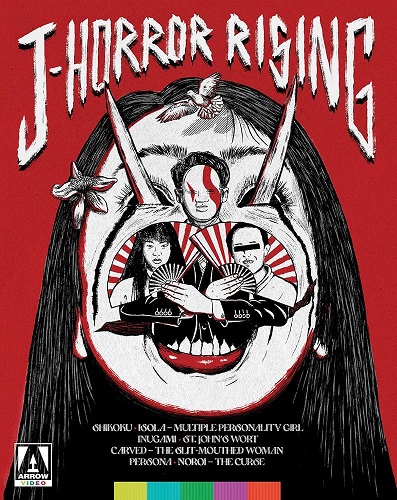
The early 1990s were a lean period for horror fans. While the 80s were chock full of titles, interest began to peter out over the next decade. Thankfully, Scream (1996) managed to jolt some life back into the genre. The other good news was the rise of J-Horror, or supernatural features made in Japan. Ringu (1998) was a massive hit in its homeland and productions exploded across the country. The 2002 North American remake became a worldwide success causing international audiences to embrace these imports. Movies like Pulse (2001), Dark Water (2002), Ju-on: The Grudge (2002) and One Missed Call (2003) were other notable efforts that inspired US remakes, but there were many others that didn’t see a release in this part of the world.
Arrow Video is now releasing a “Limited Edition” Blu-ray set containing seven J-Horror titles that received plenty of attention in their homeland, but didn’t get as big of a push in North America. Now, interested parties can check out these other titles and see how they compare with those above. The films themselves are mostly low-budget and shot-on-video, so don’t expect stellar image quality on all the titles, but this set does come with many extras and that really give one a sense of the genre and its history.
While I don’t usually review discs this way, a bonus feature on the first movie is actually essential to providing background to the pictures on this set. In an interview with film historian Tom Mes, the expert states that J-Horror was around prior to Ringu, but that the titles were low-budget and made exclusively for the home video market. It seems that many were actually tailored for female audiences. When the companies producing them saw growing interest, they decided to give the genre an upgrade.
Ringu was a rarity in that its distributor ultimately decided to give it a theatrical release and it was a smash success. Curiously enough, the title and its hit sequels were put out in cinemas as double-features with another similarly-themed effort (a few of which are titles included in this package). It seems producers were hoping that some of the accompanying features would also lend themselves to franchises, but this tactic ultimately didn’t work. While there was a huge influx over four or so years, things eventually slowed down. This interview is fascinating and gives a detailed overview of J-Horror history.
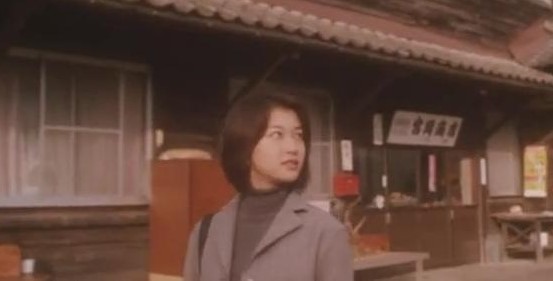
The first film included is Shikoku (1999), which is set in a small village. It follows Hinako (Yui Natsukawa), a woman moving back to her hometown. She reconnects with a childhood acquaintance (Michitaka Tsutsui), but the two find themselves haunted by Sayori (Chiaki Kuriyama) , a girl from their past who drowned mysteriously. Sayori forces the leads to confront their past. The movie is more melodramatic than one might expect and is a mixed bag overall, but has a reasonably effective climax in which the main characters reunite in an eerie outdoor space. This story also offers a few insights about loss and regret. The image veers all over the place and includes some grainy, underlit moments, but that is a part of the low-budget roots of the movie and not any fault of the transfer.
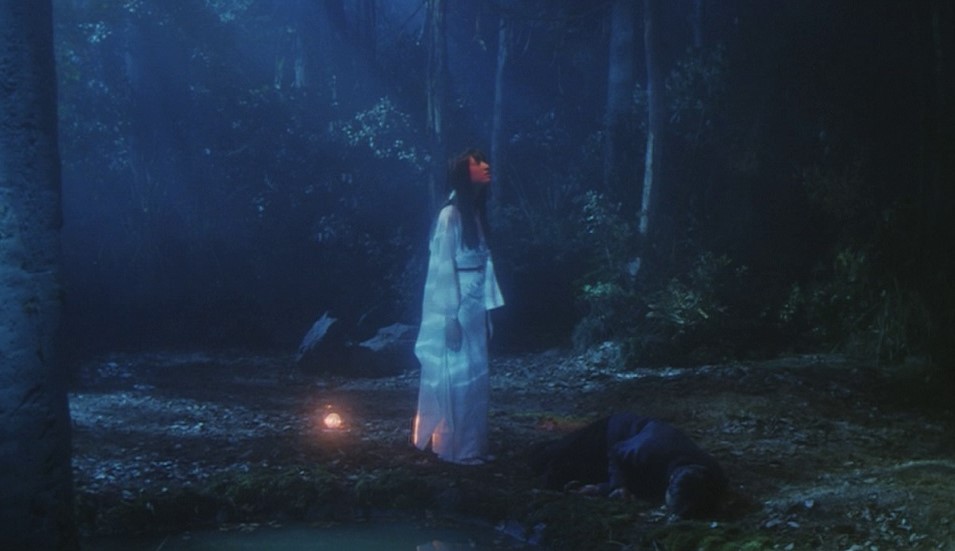
Extras on the disc are wonderful. Tom Mes returns to provide an informative commentary. There is a lengthy interview with the director, who discusses the themes of the film, stating he was more interested in the characters than the ghostly, supernatural elements. There are more archival interviews with the filmmaker and cast, as well as an on-set featurette and promo materials.
Isola: Multiple Personality Girl (2000) is a wilder and crazier feature that follows a young woman/psychic named Yakari (Yoshino Kimura) as she helps out survivors of the Great Hanshin Earthquake. The guilt-ridden lead begins to wonder if she may be partly responsible for the disaster. But soon, she encounters the title character Isola (Yu Kurosawa), a young woman who appears to be malevolent and possess supernatural powers.
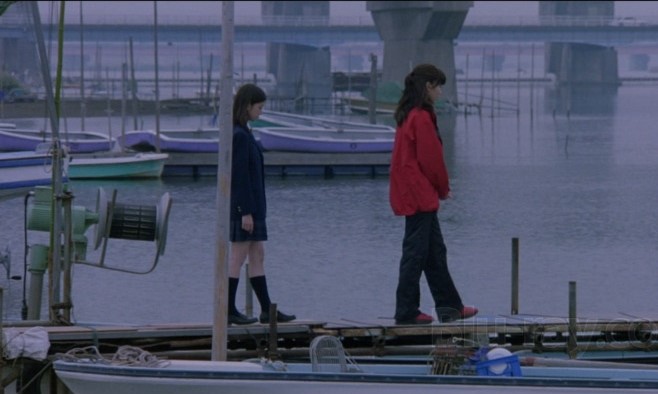
This feature includes some striking footage early on, before becoming more and more outrageous as Isola becomes involved in the proceedings. Events become increasingly trippy, eventually introducing action with a scientist working in an incredibly unsafe, dilapidated building that houses a sensory-deprivation tank. It all makes for a silly but amusing experience.
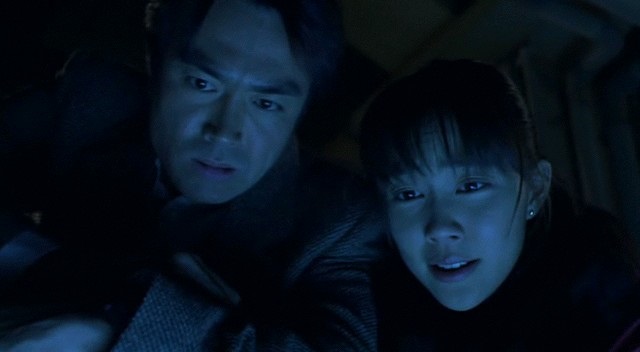
Like the first movie, the picture quality of this shot-on-video production is all over the place, but I think it’s slightly cleaner than the first movie (likely due to some interesting locations and more elaborate set design). It comes with a commentary track that gives cast and crew info, and tries to clarify some of the wilder plot elements. There are also two archived interview pieces with the female leads. A behind-the-scenes featurette, a trailer and image gallery are also included.
Inugami (2000) is one of the more eccentric pictures on the set, but one I actually appreciated more than many of the others. The production value of this title is much higher and the photography is quite attractive. There are some beautiful images in this story (including a finale shot entirely in black and white) and the picture quality is the strongest among titles on the first two discs.
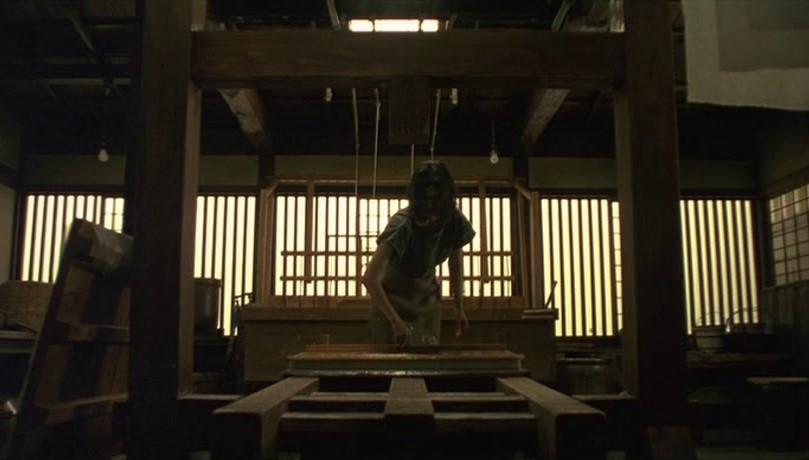
This film follows village woman and papermaker Miki (Yuki Amami) who meets teacher Akira (Atsuro Watabe), a new arrival from another town. They become romantically involved and he soon realizes that the locals really, really don’t like her. In fact, the woman’s family history involves a generations-old death curse. He doesn’t believe it at first, but soon becomes convinced that he might need to free her from it. It’s definitely an eccentric movie, but the lush visuals and performances raise it above initial expectations.
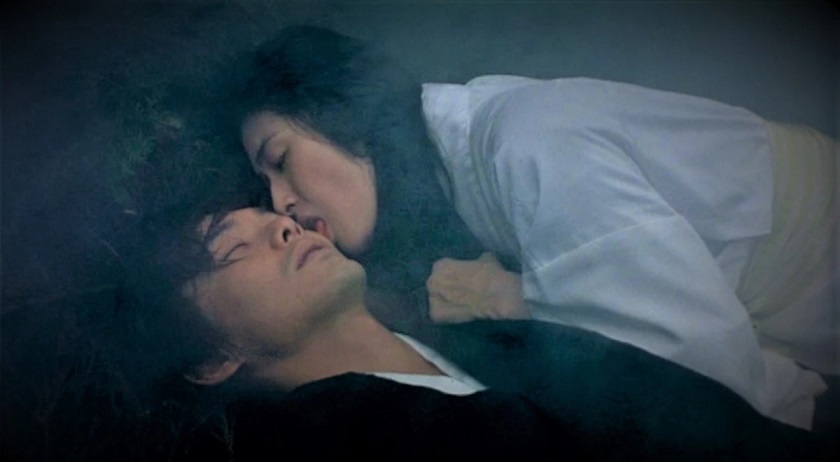
This title includes an informative film historian commentary, who goes over details about the interesting paper-making process the lead character has devoted her life to. He addresses the cultural story elements and does an excellent job of helping viewers understand them. There is also an interview with the director, who also explains what he was trying to do to elevate his chiller over other titles of its ilk. An image gallery is also included.
St. John’s Wort (2001) is my least favorite title in the set. Inspired by video games, it follows “game model” Nami (Megumi Okina) who visits a relative’s abandoned mansion and faces off against sinister forces. The picture features many plot twists, at one point even suggesting that what viewers are witnessing may also be a game.
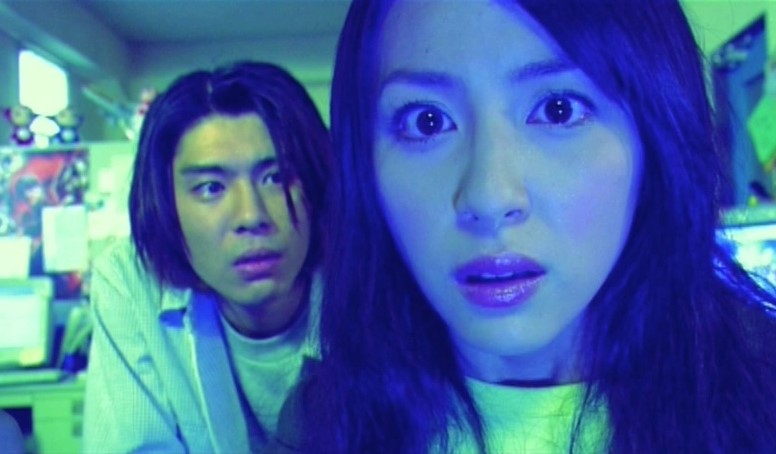
Shot-on-video, the grainy picture employs blown-out colors and visuals along with a rapid editing style that quickly becomes grating. This overly stylistic approach not only looks poor, but fails to engage viewers in the characters or their plight. I didn’t care what was really going on by the end and for this reviewer, this picture simply didn’t work.
It still has devoted fans though, and there is a film expert commentary track in which the speaker defends the movie, calling it an original and entertaining effort. You’ll get archival cast and crew interviews, a making-of an on-set introduction from Okina, trailers and TV spots, as well as an image gallery. If you do appreciate the film, you will be impressed with the bonuses.
Persona (2000) is a strange fantasy picture about a bullied high school student and fellow classmates who begin donning masks. It seems the process of wearing them allows the teens a sort of freedom in their lives, and they use their strange avatars to make big life changes. Alas, some act out and become violent in the process.
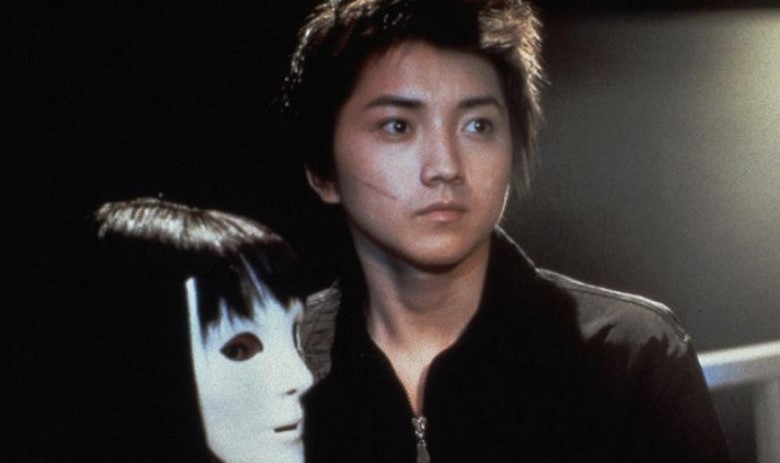
The video quality on this picture is generally strong. Several sequences look quite good, making one assume that this effort had higher production values than some of the other titles. And the masks are visually striking as well. This is a very strange picture, but one that is interesting in terms of subject matter and completely unlike other teen pictures.
As for bonus features, the director gives an informative interview about the movie and notes that he was interested in how anonymity can change behavior from socially acceptable to downright horrible. He explains the film as being an examination of mob mentality. This picture comes with an image gallery.
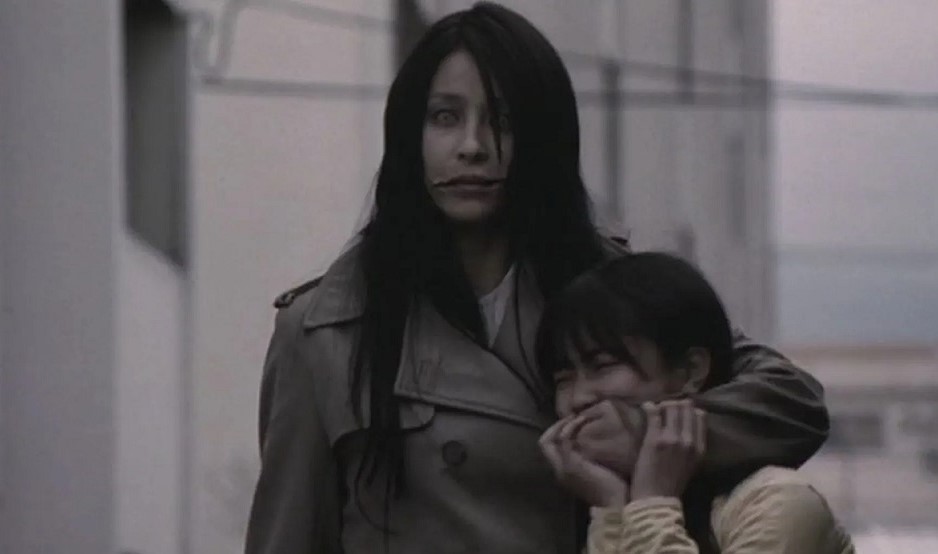
If you’re a parent, Carved: The Slit- Mouthed Woman (2007) will definitely strike a nerve. Based on the urban legend of Kuchisake-onna, an earthquake frees a supernatural figure (Niki Mizuno) with a horribly disfigured face (wearing a surgical mask). She goes about stalking children and brutally murdering them with shears. An elementary school teacher (Eriko Sato) attempts to stop the monster. The movie makes no bones about killing children and several are kidnapped and/or mutilated. If that wasn’t bad enough, some youngsters in the picture also suffer abuse from their parents.
The movie isn’t in great taste and can feel a bit exploitative, but I cannot deny that many scenes were upsetting, disturbing and creatively lensed. When the title villain opens her mouth, it’s a jarring sight. It’s definitely tense to see plenty of likable kids in this kind of horrible danger and is generally successful as a horror picture. Overall, the image quality is good with a little bit of noise and grain, but nothing that is distracting or overbearing.
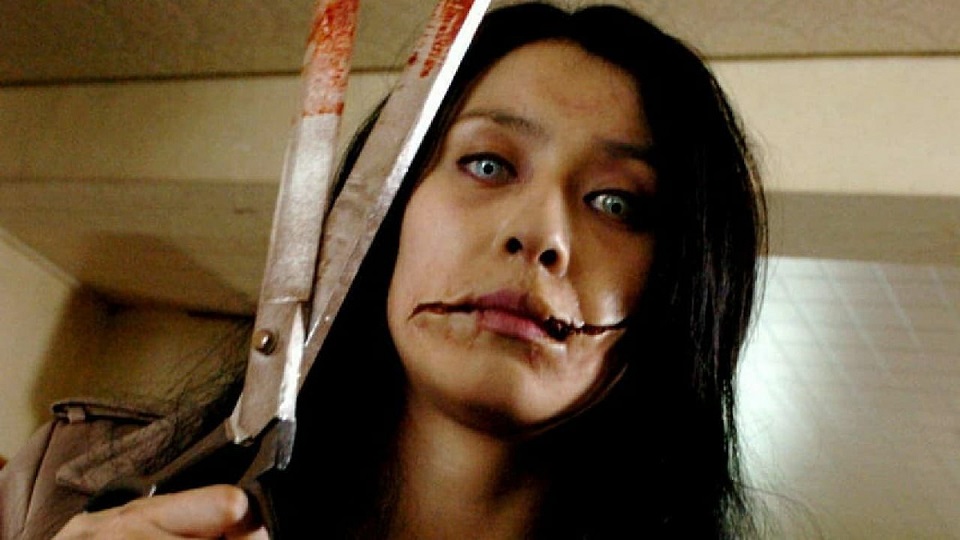
Legends like these often serve to teach children (and adults) life lessons, and the director explains how he turned this one into a motion picture. He admits that on its owinugamiln, the original tale is silly, so he tried to invent a backstory and deal with themes like child abuse to give his film more dramatic weight. The filmmaker also notes that his first drafts didn’t include adults and featured even more victimized kids, but that his producer ultimately (and perhaps wisely) suggested he show some reserve. This disc also includes an informative movie expert commentary track, an analysis with a J-Horror expert and a featurette on the original legend. And it comes with image galleries.
Finally, Noroi: The Curse (2005) is a “found footage” tale about Masafum Kobayashi (Jin Muraki) a ghost-hunting documentarian who has disappeared. Viewers see footage of his previous investigations of supernatural figures out in the wild, with the lead befriending female actress Marika Matsumoto (playing a fictionalized version of herself) in addition to an amusingly unhinged, tin-foil wearing medium named Osawa (Takashi Kiakizawa). The story jumps around in time, eventually connecting all indvidudal segments and showing what actually happened to Kobayashi.
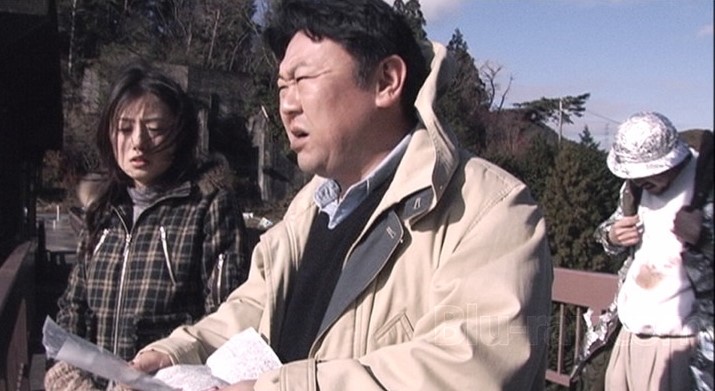
The movie was shot documentary-style and thus looks the part. The image quality isn’t crystal clear, but it looks 100% appropriate for this type of movie. It’s a long film at nearly two hours, but is well-acted. The story does take plenty of creepy twists and turns and possesses a nicely dark sense of humor. And it all pays off well with an effective finale. Truth be told, this is one of the better “found footage” titles of its era and is one of the best pictures on the set. It will certainly please anyone who appreciates this type of chiller.
This picture comes with a film expert commentary who notes the many unique elements of the story. Perhaps the best bonus is an interview with the director (who also helmed Carved: The Slit- Mouthed Woman). He states that he got his start making straight-to-video paranormal investigation titles before graduating to narrative films. Apparently, his greatest cinematic inspiration is Man Bites Dog, and he describes how that movie influenced his work in general. His past experiences suggest that he knew exactly how to tell this story, which may be why it works as well as it does. The filmmaker also notes that there are some hidden clues revealing what the murderous beings really are that may raise a smile.
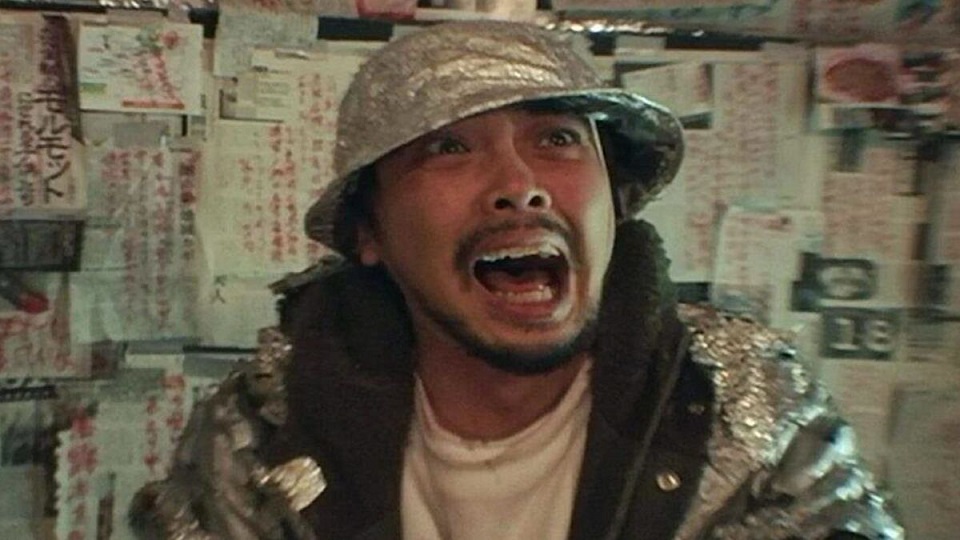
There is also an informative discussion with the producer of this, and many other titles featured in the set, as well as featurettes analyzing the “mockumentary” style and a critical study of the picture. Bonus footage, EPK material, promo trailers and TV spots, as well as several deleted scenes are also present.
J-Horror Rising from Arrow Video is a detailed Blu-ray set that finally allows western viewers to see some less-familiar Japanese horror movies from the early 2000s. They don’t all work and may not be classics like Ringu, but a few are very effective and worth your time. These were mostly made on-the-cheap, so the presentation isn’t reference quality, but it is as good as it can possibly be. And the bonus features are enlightening, so even horror fans may learn something new about this brief but busy era in Japanese horror filmmaking. It’s an excellent set.


